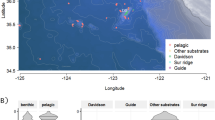Abstract
Bioluminescence is the production of light from living organisms, a phenomenon which is commonplace in the ocean. For polychaetes, because many pelagic species are difficult to catch in good condition, they remain almost completely unstudied compared to coastal species that are more easily captured by researchers. In this work, bioluminescence spectra are reported in vivo from three pelagic species, a blue-green light-emitting specimen of Tomopteris sp. (Phyllodocidae), a genus whose species are generally reported to emit yellow light, and two Flabelligeridae, Poeobius meseres, and Flota flabelligera. All three species generate light along the whole length of the body, at distinct spots for F. flabelligera and Tomopteris sp. The light emission peaks are very similar to each other, ranging from 493 to 497 nm, similar to the in vitro bioluminescence peak for the more thoroughly studied Odontosyllis enopla. This wavelength is red-shifted compared to many other pelagic animals, but blue-shifted compared to polynoid worms. This is the first report of bioluminescence from F. flabelligera and P. meseres and the first reported spectrum of a blue-light-emitting Tomopteris sp from the Pacific.



Similar content being viewed by others
References
Bassot JM, Nicolas MT (1995) Bioluminescence in scale-worm photosomes: the photoprotein polynoidin is specific for the detection of superoxide radicals. Histochem Cell Biol 104(3):199–210
Branchini BR, Behney CE, Southworth TL, Rawat R, Deheyn DD (2014) Chemical analysis of the luminous slime secreted by the marine worm Chaetopterus (annelida, polychaeta). Photochem Photobiol 90(1):247–251
Deheyn DD, Latz MI (2009) Internal and secreted bioluminescence of the marine polychaete Odontosyllis phosphorea (Syllidae). Invert Biol 128(1):31–45
Deheyn DD, La Enzor, Dubowitz A, Urbach JS, Blair D (2013) Optical and physicochemical characterization of the luminous mucous secreted by the marine worm Chaetopterus sp. Physiol Biochem Zool 86(6):702–705
Francis WR, Powers ML, Haddock SHD (2014) Characterization of an anthraquinone fluor from the bioluminescent, pelagic polychaete Tomopteris. Luminescence 29(8):1135–1140
Gouveneaux A, Mallefet J (2013) Physiological control of bioluminescence in a deep-sea planktonic worm, Tomopteris helgolandica. J Exp Biol 216(Pt 22):4285–4289
Gouveneaux A, Flood PR, Mallefet J (2016) Unexpected diversity of bioluminescence in planktonic worms. Luminescence. doi:10.1002/bio.3192
Haddock SH, Moline MA, Case JF (2010) Bioluminescence in the sea. Annu Rev Mar Sci 2(1):443–493
Haddock SHD, Case JF (1999) Bioluminescence spectra of shallow and deep-sea gelatinous zooplankton: ctenophores, medusae and siphonophores. Mar Biol 133(3):571–582
Harvey EN (1952) Bioluminescence, 1st edn. Academic Press Inc, New York
Hastings J (1996) Chemistries and colors of bioluminescent reactions: a review. Gene 173(1):5–11
Latz MI, Frank TM, Case JF (1988) Spectral composition of bioluminescence of epipelagic organisms from the Sargasso sea. Mar Biol 98(3):441–446
Loening AM, Wu AM, Gambhir SS (2007) Red-shifted Renilla reniformis luciferase variants for imaging in living subjects. Nat Methods 4(8):641–643
Malikova NP, Stepanyuk GA, Frank LA, Markova SV, Vysotski ES, Lee J (2003) Spectral tuning of obelin bioluminescence by mutations of Trp92. FEBS Lett 554(1–2):184–188
Nicol JAC (1957a) Spectral composition of the light of Chaetopterus. J Mar Biol Association U. K. 36(03):629
Nicol JAC (1957b) Spectral composition of the light of polynoid worms. J mar biol Ass UK 36(6260):529–538
Osborn KJ, Haddock SHD, Pleijel F, Madin LP, Rouse GW, Greg W (2009) Deep-sea, swimming worms with luminescent “bombs”. Science 325(5943):964
Osborn KJ, Haddock SHD, Rouse GW (2011) Swima (Annelida, Acrocirridae), holopelagic worms from the deep Pacific. Zoolog J Linn Soc 163(3):663–678
Petushkov VN, Ma Dubinnyi, Tsarkova AS, Rodionova NS, Baranov MS, Kublitski VS, Shimomura O, Yampolsky IV (2014) A novel type of luciferin from the Siberian luminous earthworm Fridericia heliota: structure elucidation by spectral studies and total synthesis. Angewandte Chemie (International Ed) 53(22):5566–8
Robison BH (2004) Deep pelagic biology. J Exp Mar Biol Ecol 300(1–2):253–272
Schlining B, Stout N (2006) MBARI’s Video Annotation and Reference System. In: OCEANS 2006, IEEE, pp 1–5
Shimomura O (2006) Bioluminescence: chemical principles and methods. World Scientific Publishing Company, Incorporated, Singapore
Shimomura O, Johnson FH, Saiga Y (1963) Partial purification and properties of the Odontosyllis luminescence system. J Cell Comp Physiol 61(3):275–292
Zörner SA, Fischer A (2007) The spatial pattern of bioluminescent flashes in the polychaete Eusyllis blomstrandi (Annelida). Helgoland Mar Res 61(1):55–66
Acknowledgements
WRF would like to thank O. Shimomura for helpful advice. We thank the ROV pilots and ship crews for their expert operations.
Author information
Authors and Affiliations
Corresponding authors
Ethics declarations
Funding
This study was funded by the NIH National Institute of General Medical Sciences (R01-GM087198) to SHDH. This research was also supported by the David and Lucile Packard Foundation through the Monterey Bay Aquarium Research Institute.
Conflict of interest
All authors declare no conflict of interest.
Ethical approval
Animals were collected under permit SC-4029 issued to SHD Haddock by the California Department of Fish and Wildlife. All animals were treated humanely, though species used are unprotected and unregulated, and no vertebrates or octopus were used, so the International and NIH ethics guidelines are not invoked.
Additional information
Responsible Editor: J. Grassle.
Reviewed by Undisclosed experts.
Rights and permissions
About this article
Cite this article
Francis, W.R., Powers, M.L. & Haddock, S.H.D. Bioluminescence spectra from three deep-sea polychaete worms. Mar Biol 163, 255 (2016). https://doi.org/10.1007/s00227-016-3028-2
Received:
Accepted:
Published:
DOI: https://doi.org/10.1007/s00227-016-3028-2




